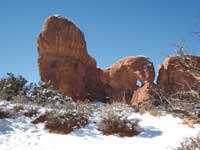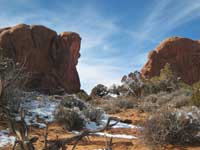Arches, along with all our other national parks, is a showcase of America’s best treasures – a precious bounty of spectacular scenery and unique habitat that should never be taken for granted. On March 1, 1872 Yellowstone, with its amazing display of geysers and hot springs, was designated as our first national park. Forty-four years later, Congress created the National Park Service, which now oversees 58 national parks; Utah ranks highest in numbers with five: Arches, Bryce, Canyonlands, Capitol Reef and Zion.
Some of the earliest settlers in Moab made regular excursions into “The Arches,” and word started to spread about this arch-filled wonderland. But it stayed low-key until December 1922 when the gold mining prospector Alexander Ringerhoffer wandered into Klondike Bluffs, where he stumbled upon Tower Arch and the other splendid formations in that region. Anxious to publicize his discovery, he mailed a letter to the Rio Grande Western Railroad, a correspondence that eventually spurred a campaign to establish “Arches” as a national monument or park.
 On April 12, 1929, this possibility turned into a reality when President Herbert Hoover signed the order to reserve 4,520 acres as Arches National Monument. Then Lyndon Johnson issued an executive order to increase its size to 82,953 acres, one of his last acts in office. In 1971, Congress reduced the area by 9,574 acres but upgraded it to a national park. The final transformation took place in October 1998 when President Bill Clinton added 3,140 acres of Lost Spring Canyon, which increased it to 76,519 acres.
On April 12, 1929, this possibility turned into a reality when President Herbert Hoover signed the order to reserve 4,520 acres as Arches National Monument. Then Lyndon Johnson issued an executive order to increase its size to 82,953 acres, one of his last acts in office. In 1971, Congress reduced the area by 9,574 acres but upgraded it to a national park. The final transformation took place in October 1998 when President Bill Clinton added 3,140 acres of Lost Spring Canyon, which increased it to 76,519 acres.
Hosting more than a million people every year, the park’s biggest draws are Delicate Arch, Devil’s Garden, Balanced Rock and The Windows. The lesser-known Double Arch, however, should also be included on every visitor’s must-see list. Due to its humungous size – the highest and third longest in the park - it is one of the more dramatic spans on display in this locality.
The salmon-colored Entrada Sandstone is the major building block of arch formation in this little corner of the universe, and scientists believe most of them were created during the last million years. In most cases the foundation is a narrow sandstone wall called a fin. Water acts as the sledgehammer when it seeps into the cracks, freezes and expands with so much pressure that chunks of rocks fall out, until eventually there’s an opening. Even today this process continues.
 Sometimes, however, an arch begins in a depression – a pothole - on the top of a fin near a cliff face where water seeping through forms an alcove. Meanwhile erosion is deepening the pothole from above until an opening is created and a pothole arch, such as Double Arch, is born. Double Arch began as a single identity and ended up as a twin. In the past this formative feature was also called Double Windows, Twinbow Bridges and the Jug Handles.
Sometimes, however, an arch begins in a depression – a pothole - on the top of a fin near a cliff face where water seeping through forms an alcove. Meanwhile erosion is deepening the pothole from above until an opening is created and a pothole arch, such as Double Arch, is born. Double Arch began as a single identity and ended up as a twin. In the past this formative feature was also called Double Windows, Twinbow Bridges and the Jug Handles.
To get to Double Arch drive five miles north from the center of town on Highway 191 to the entrance station. Then continue 9.2 miles and turn right at the sign for The Windows. The road ends in 2.5 miles at the trailhead for Double Arch, which is located at the second parking area. During the busy tourist season it fills up fast and the early bird is the one who will more easily find a parking spot!
The ¼ mile sandy trail easily transports me through the trademark high desert vegetation of blackbrush, juniper, yucca, pinyon pine and Mormon tea. After a short climb in to a rocky amphitheater, craning my neck I stare directly above at the staggering proportions of Double Arch - a whopping 144 foot width by 112 foot height. Its smaller sibling, also a hulking giant, impressively measures in at 67 feet wide, 86 feet high.
 My neck craning position can only last so long and with a sigh of relief I stretch out on a large hard-rock bench. Now I can more comfortably absorb the immensity of these two gigantic skylights framing a satiny blue sky as four ravens flap in and out of the open windows. I have seen pothole arches before, but nothing compares to the monstrous proportions of these two.
My neck craning position can only last so long and with a sigh of relief I stretch out on a large hard-rock bench. Now I can more comfortably absorb the immensity of these two gigantic skylights framing a satiny blue sky as four ravens flap in and out of the open windows. I have seen pothole arches before, but nothing compares to the monstrous proportions of these two.
Eventually I am casting my vision out to another attention-grabbing scene where a wintry geologic landscape awaits my inspection - a tantalizing sideways glimpse of The Windows - a massive series of rocks called The Parade Of Elephants – and a topsy-turvy balanced rock. But there’s more, so much more, as this exhibit of odd-shaped rocks continues – imaginative castles and buttressing towers – bulbous pillars of stone – and obsessively fat sandstone thumbs protruding from the ground. Augmenting this already stunning vista is the dazzling creamy-white brilliance of the La Sals featuring South Mountain and Mt.Tukuhnikivatz, a starring cast of sparkling jewels on the southeastern horizon.
 For a while I have this prized front row seat all to myself and I savor these fleeting moments of soothing solitude. The only sounds to be heard pour forth from the ravens – cawing and gurgling vocalizations performed by a playful corvid quartet.
For a while I have this prized front row seat all to myself and I savor these fleeting moments of soothing solitude. The only sounds to be heard pour forth from the ravens – cawing and gurgling vocalizations performed by a playful corvid quartet.
Before long a few sightseers trickle in. Upon their arrival I can’t help but notice their various reactions to this wondrous treasure. A young girl broadcasts “Echoes, Echoes, Echoes” in hopes the stone walls will respond. Full-of-energy kids try out their rock-hopping skills, while others just quietly watch and admire. They have all come here to appreciate, each in his own way, this amazing feat of geology as a first time visitor succinctly sums it up in one word - “Wow!”
Fortunately our ancestors had the foresight to understand the need to create a national park system that is accessible to the entire public. Yosemite, Glacier, the Grand Canyon, etc. are part of our American heritage, and we are so lucky to have Canyonlands and Arches in our backyard for people from all parts of the world to enjoy.
 On April 12, 1929, this possibility turned into a reality when President Herbert Hoover signed the order to reserve 4,520 acres as Arches National Monument. Then Lyndon Johnson issued an executive order to increase its size to 82,953 acres, one of his last acts in office. In 1971, Congress reduced the area by 9,574 acres but upgraded it to a national park. The final transformation took place in October 1998 when President Bill Clinton added 3,140 acres of Lost Spring Canyon, which increased it to 76,519 acres.
On April 12, 1929, this possibility turned into a reality when President Herbert Hoover signed the order to reserve 4,520 acres as Arches National Monument. Then Lyndon Johnson issued an executive order to increase its size to 82,953 acres, one of his last acts in office. In 1971, Congress reduced the area by 9,574 acres but upgraded it to a national park. The final transformation took place in October 1998 when President Bill Clinton added 3,140 acres of Lost Spring Canyon, which increased it to 76,519 acres. Sometimes, however, an arch begins in a depression – a pothole - on the top of a fin near a cliff face where water seeping through forms an alcove. Meanwhile erosion is deepening the pothole from above until an opening is created and a pothole arch, such as Double Arch, is born. Double Arch began as a single identity and ended up as a twin. In the past this formative feature was also called Double Windows, Twinbow Bridges and the Jug Handles.
Sometimes, however, an arch begins in a depression – a pothole - on the top of a fin near a cliff face where water seeping through forms an alcove. Meanwhile erosion is deepening the pothole from above until an opening is created and a pothole arch, such as Double Arch, is born. Double Arch began as a single identity and ended up as a twin. In the past this formative feature was also called Double Windows, Twinbow Bridges and the Jug Handles. My neck craning position can only last so long and with a sigh of relief I stretch out on a large hard-rock bench. Now I can more comfortably absorb the immensity of these two gigantic skylights framing a satiny blue sky as four ravens flap in and out of the open windows. I have seen pothole arches before, but nothing compares to the monstrous proportions of these two.
My neck craning position can only last so long and with a sigh of relief I stretch out on a large hard-rock bench. Now I can more comfortably absorb the immensity of these two gigantic skylights framing a satiny blue sky as four ravens flap in and out of the open windows. I have seen pothole arches before, but nothing compares to the monstrous proportions of these two.  For a while I have this prized front row seat all to myself and I savor these fleeting moments of soothing solitude. The only sounds to be heard pour forth from the ravens – cawing and gurgling vocalizations performed by a playful corvid quartet.
For a while I have this prized front row seat all to myself and I savor these fleeting moments of soothing solitude. The only sounds to be heard pour forth from the ravens – cawing and gurgling vocalizations performed by a playful corvid quartet.